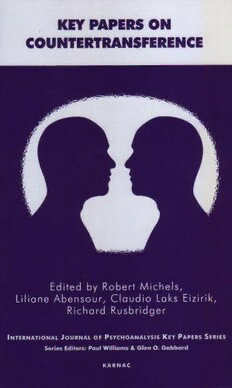
Key Papers on Countertransference: IJP Education Section PDF
Preview Key Papers on Countertransference: IJP Education Section
KEY PAPERS ON COUNTERTRANSFERENCE Edited by Robert Michels, Liliane Abensour, Claudio Laks Eizirik, Richard Rusbridger INTERNATIONAL JOURNAL OF PSYCHOANALYSIS K EY PAPERS SERIES Series Editors: Paul Williams & Glen O. Gabbard KARNAC KEY PAPERS ON COUNTERTRANSFERENCE l)P EDUCATION SECTION KEY PAPERS ON COUNTERTRANSFERENCE IJP EDUCATION SECTION edited by Robert Michels Liliane Abensour Claudio Laks Eizirik Richard Rusbridger International Journal of Psychoanalysis Key Papers Series Series Editors: Paul Williams and Glen O. Gabbard K A R N AC LONDON NEW YORK First published in 2002 by H. Karnac (Books) Ltd, 118 Finchley Road, London NW3 5HT Arrangement, Introduction © 2002 Institute of Psychoanalysis; chapters 2-5 copyright © 2002 Institute of Psychoanalysis, republished by permission of the International Journal of Psychoanalysis. The rights of the authors of this work have been asserted in accordance with §§ 77 and 78 of the Copyright Design and Patents Act 1988. All rights reserved. No part of this publication may be reproduced, stored in a retrieval system, or transmitted, in any form or by any means, electronic, mechanical, photocopying, recording, or otherwise, without lite prior written permission of the publisher. British Library Cataloguing in Publication Data A C1 J*, for this book is available from the British library ISBN 978 1 85575 961 9 Produced for Karnac Books Ltd by The Studio Publishing Services Ltd, 4A Brookside Units, Venny Bridge, Exeter EX4 8JN wwwicaiTiacbooks.com CONTENTS SERIES PREFACE vii Introduction 1 1: Countertransference past and present a review of the concept by Theodore J. Jacobs 7 2: Countertransference by R. D. Hinskelzoood 41 3: Hie countertransference: a Latin American view by Beairiz de Ledn de Bernardi 81 4: Hie countertransference scene in France by Frangois Duparc 117 SERIES PREFACE The International Journal of Psychoanalysis Key Papers Series This series brings together the most important psychoanalytic papers in the Journal's eighty-year history, in a series of accessible monographs. The idea behind the series is to approach the IJP's intellectual resource from a variety of perspectives in order to highlight important domains of psychoanalytic enquiry. It is hoped that these volumes will be of interest to psychoanalysts, students of the discipline and, in particular, to those who work and write from an interdisdplinary standpoint. The ways in which the papers in the monographs are grouped will vary: for example, a number of 'themed' monographs will take as their subject important psycho analytic topics, while others will stress interdisciplinary links (between neuroscience, anthropology, philosophy etc. and psycho analysis). Still others will contain review essays on, for example, film and psychoanalysis, art and psychoanalysis and the worldwide IJP Internet Discussion Group, which debates important papers before they appear in the printed journal (cf. www.ijpa.org). The aim of all the monographs is to provide the reader with a substantive contribution of the highest quality that reflects the principal concerns of contemporary psychoanalysts and those with vii Viii K£V PAPERS O N COUNTERTRANSF£R€NC€ whom they are in dialogue. We hope you will find the monographs rewarding and pleasurable to read. Paul Williams and Glen O. Gabbard Joint Editois-in-Chiet International Journal of Psychoanalysis London, 2002 Introduction RICHARD RUSBR1DGER It often happens in psychoanalysis that phenomena which are first described as abnormal are later seen to occur more generally and normally* This is true of psychoanalysis as a theory of mind and of development, as seen in the case of the Oedipus complex, which Freud first described as pathological and later as universal and normal. It is also true of psychoanalysis as a psychotherapy, as in the case of the transference. This was initially seen by Freud as an impediment to therapeutic progress; later as one of the main means of making therapeutic progress; and finally as a universal theme of all relatiorahips. Freud's notion of the transference also broadened in that he changed from seeing it as manifested in particular transferences as they came up in sessions—as in his treatment of Dora (Freud, 1905 [19011) or of the Rat Man (Freud, 1909}—to seeing the transference more widely as arepetition in the therapy of all the patient's characteristic infantile conflicts. Psychoanalysis is both a study of psychic pathology and, derived from that, an account of normal psychology- The move from seeing a phenomenon as pathology to describing it in normality is nowhere as marked as with the notion of counter transference. Freud used it—first in a letter to Jung in 1909 (Freud &
